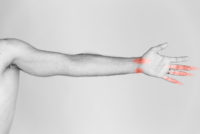 The flexors of your wrist and fingers work together to bend your wrist and curl your fingers. They are not differentiated in the same way that the finger and wrist extensors are. Pain may occur in just one or two fingers, with or without pain at the wrist.
The flexors of your wrist and fingers work together to bend your wrist and curl your fingers. They are not differentiated in the same way that the finger and wrist extensors are. Pain may occur in just one or two fingers, with or without pain at the wrist.
 The hallmark of finger flexor pain is that it feels as if it extends past the fingertips. You may not even be able to tell which side of your finger hurts, but if it hurt through the length of the finger to the tip and beyond, you have a trigger point in a finger flexor. Similarly with the thumb flexor – the pain projects to the tip and beyond.
The hallmark of finger flexor pain is that it feels as if it extends past the fingertips. You may not even be able to tell which side of your finger hurts, but if it hurt through the length of the finger to the tip and beyond, you have a trigger point in a finger flexor. Similarly with the thumb flexor – the pain projects to the tip and beyond.
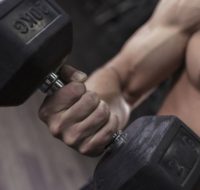 Unlike the extensors, finger and wrist flexors are activated more by sustained contraction and shortening than repetition. Activities that can activate wrist and finger flexor trigger points include: gripping the steering wheel tightly during a long ride, paddling or rowing a canoe, kayak, scull, etc. with a tight grasp, gripping a weight tightly when working out, and grasping a ski pole or hand tool for hours at a time. The combined effects of flexion, twisting, pulling can cause trigger point pain in the thumb from pulling weeds.
Unlike the extensors, finger and wrist flexors are activated more by sustained contraction and shortening than repetition. Activities that can activate wrist and finger flexor trigger points include: gripping the steering wheel tightly during a long ride, paddling or rowing a canoe, kayak, scull, etc. with a tight grasp, gripping a weight tightly when working out, and grasping a ski pole or hand tool for hours at a time. The combined effects of flexion, twisting, pulling can cause trigger point pain in the thumb from pulling weeds.
In addition to pain at rest, you may have difficulty using scissors, using a round brush, and placing curls, clips, or blow-drying your hair. A manual screwdriver, pliers, or pruner may be hard to use. Tools with small handles stress your finger flexors more than thicker handles.
Trigger points in the flexors can be easily prevented by moderating gripping activities, stretching, and relaxing the muscles of the forearm.
 The hallmark of finger flexor pain is that it feels as if it extends past the fingertips. The pain is often described as explosive. You may not even be able to tell which side of your finger hurts, but if it hurt through the length of the finger to the tip and beyond, you have a trigger point in a finger flexor. Similarly with the thumb flexor – the pain projects to the tip and beyond.
The hallmark of finger flexor pain is that it feels as if it extends past the fingertips. The pain is often described as explosive. You may not even be able to tell which side of your finger hurts, but if it hurt through the length of the finger to the tip and beyond, you have a trigger point in a finger flexor. Similarly with the thumb flexor – the pain projects to the tip and beyond.
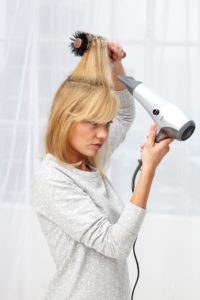 In addition to pain at rest, you may have difficulty using scissors, using a round brush, and placing curls, clips, or blow-drying your hair.
In addition to pain at rest, you may have difficulty using scissors, using a round brush, and placing curls, clips, or blow-drying your hair.
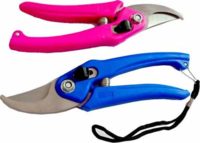 A manual screwdriver, pliers, or pruner may be hard to use. Tools with small handles stress your finger flexors more than thicker handles. Choose tools with larger, comfortable handles.
A manual screwdriver, pliers, or pruner may be hard to use. Tools with small handles stress your finger flexors more than thicker handles. Choose tools with larger, comfortable handles.
Other well-defined disorders of the hand, arm, and shoulder can be perpetuated by dysfunction of the finger flexors.
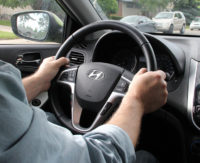 The pain from finger flexor trigger points can be easily avoided by reducing grip stress, stretching, and relaxing the forearm.
The pain from finger flexor trigger points can be easily avoided by reducing grip stress, stretching, and relaxing the forearm.
Avoid actions that overload the wrist and finger flexor muscles with extended gripping. When driving, lower your hands to the 3 and 9 position, allowing full control of the steering wheel with less gripping.
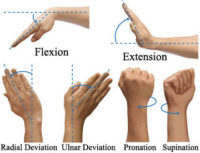 Limit ulnar deviation of the wrist, especially during workouts, tool use, and racquet sports. Maintain a neutral wrist by deliberately cocking it slightly towards the thumb side.
Limit ulnar deviation of the wrist, especially during workouts, tool use, and racquet sports. Maintain a neutral wrist by deliberately cocking it slightly towards the thumb side.
When using an oar or paddle in rowing, sculling, canoeing, or kayaking: grasp only on the pulling side of your stroke. Release the tension in your hand on the return stroke. With kayak paddles, this means alternating the grip with each stroke, which may be preferred over punishing one hand more than the other.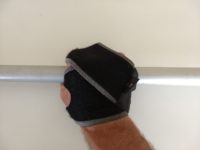
A variety of supports and pads are available for rowing and paddling. All of them reduce strain on the wrist and finger flexors.
If you strength train, limit the use of barbells and other free weights that require tight gripping of the bar. Body weight and resistance training may be more kind to your hands.
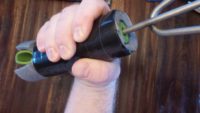 Make sure that hand tools and handles are not too small. A diameter of about 1 – 1/2″ is comfortable; smaller handles will cause you to clench too tightly.
Make sure that hand tools and handles are not too small. A diameter of about 1 – 1/2″ is comfortable; smaller handles will cause you to clench too tightly.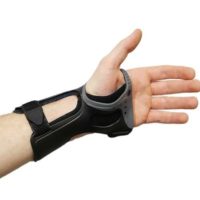
Try to reduce passive flexion of your wrist and finger flexors, especially when sleeping. Consider using a wrist guard similar to below at night. They are often sold for carpal tunnel syndrome. Keep your palm open at night.
Myofascial self-care always starts with establishing a foundation of diaphragmatic breathing. Once you have taken a few moments to get in touch with your breath, we move on to self-compression and stretching. You may find that a warm bath or shower, or applying moist heat before you begin is helpful.
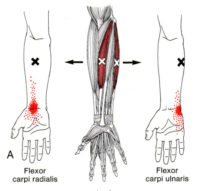
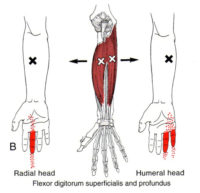
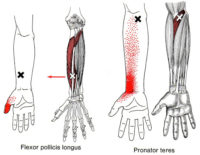
You can use pressure self-release for the wrist and finger flexors while seated. It helps your forearm relax if it is well supported by a pillow or other padded armrest.
Note that the wrist and finger flexor trigger points are at about the same distance down the arm and separated just 1/2″ to 1″. The trigger point locations for flexor pollicis and pronator teres are quite different with pain from booth projecting to parts of your thumb.
Using your hand from the unaffected side, begin by using your fist to gently massage the underside of your forearm. Explore the muscles, note areas that are sorer, and bring your focus to them.
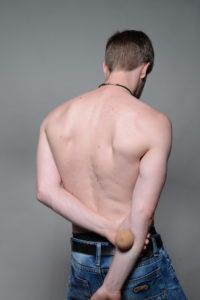
To compress specific trigger points, you can use a massage ball. This ball is cork and is about the size of a golf ball, but softer. A tennis ball is too large and too soft. Find the tender spot and apply pressure for up to 30 seconds as pain decreases. You can do this three to five times.
Try flexing and extending your wrist and fingers as you compress these areas.
The most pinpoint pressure and accuracy comes from using the knuckle of your index finger. Make a loose fist with the remaining fingers, extend the knuckle of your index finger and support it with your thumb.
Many blood vessels and nerves in the arm are superficial, so pressure self-release should be done with caution. If you feel tingling or circulation changes in your hand you should reposition and take a different approach.
After completing self-compressions, move your wrist and fingers through their range of motion and prepare to gently stretch your wrist and finger flexors. Begin by shaking out your hands and fingers in a “finger flutter” exercise and do a few wrist circles. Continue with the stretches below:
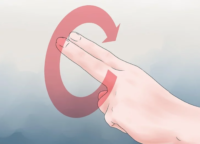
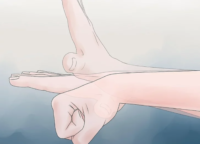
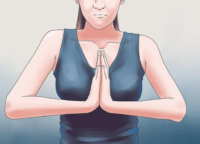
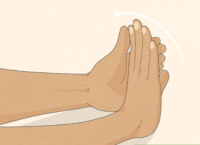
You can use your breath to deepen the stretches shown.
If you experience pain following pressure release and stretching, a cold pack may be helpful.
The 40-minute video below discusses the treatment of hand and finger pain from a physical therapy perspective, including the use of a hand massage called the iPalm:
If you maintain a posture or activity that activates a trigger point in any muscle it will continue.



Unlike the extensors, finger and wrist flexors are activated more by sustained contraction and shortening than repetition. This means maintaining your grip for long periods of time.
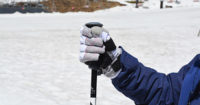 Activities that can activate wrist and finger flexor trigger points include: gripping the steering wheel tightly during a long ride, paddling or rowing a canoe, kayak, scull, etc. with a tight grasp, gripping a weight tightly when working out, and grasping a ski pole or hand tool for hours at a time.
Activities that can activate wrist and finger flexor trigger points include: gripping the steering wheel tightly during a long ride, paddling or rowing a canoe, kayak, scull, etc. with a tight grasp, gripping a weight tightly when working out, and grasping a ski pole or hand tool for hours at a time.
When pulling weeds, the combined effects of flexion, twisting, pulling can cause trigger points in the flexor pollicis longus and pronator teres, leading to pain the thumb and base of the thumb.
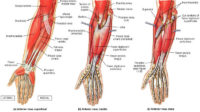 There are two wrist flexors, two finger flexors, and one thumb flexor. Pronator teres, which pronates the arm, is included because of the common activation factors and its relationship to other thumb pain.
There are two wrist flexors, two finger flexors, and one thumb flexor. Pronator teres, which pronates the arm, is included because of the common activation factors and its relationship to other thumb pain.
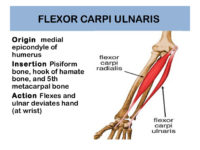 Flexor carpi ulnaris flexes the wrist and deviates it toward the pinky.
Flexor carpi ulnaris flexes the wrist and deviates it toward the pinky.
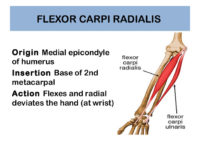 Flexor carpi radialis flexes the wrist and deviates it towards the thumb.
Flexor carpi radialis flexes the wrist and deviates it towards the thumb.
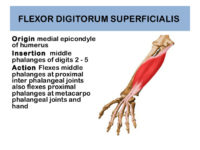 Flexor digitorum superficialis flexes all four fingers in two separate groups at the proximal interphalangeal joints (knuckle). However, under continued action, it also flexes the metacarpophalangeal joints (hand) and wrist joint.
Flexor digitorum superficialis flexes all four fingers in two separate groups at the proximal interphalangeal joints (knuckle). However, under continued action, it also flexes the metacarpophalangeal joints (hand) and wrist joint.
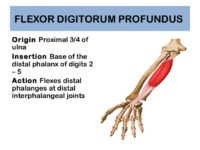
Flexor digitorum profundus is a flexor of the wrist, hand and finger joints. The lumbricals, intrinsic muscles of the hand, attach to the tendon of flexor digitorum profundus. Thus, the flexor muscle is used to aid the lumbrical muscles in their role as extensors of the interphalangeal joints. As the lumbrical muscles originate on the palmar side of the hand and attach to the dorsal aponeurosis, power is transferred from the flexor digitorum profundus muscle to fully extend the fingers as well as flex the metacarpophalangeal joints.
The tension generated by flexor digitorum profundus at the furthest finger joints is determined by wrist position. Flexion of the wrist causes muscle shortening at that point, reducing tension that can be generated more distally. Fingers cannot be fully flexed if the wrist is fully flexed.
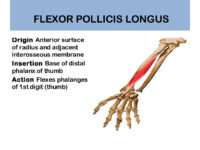
The flexor pollicis longus flexes the thumb, flexes the joints of the thumb. This is related to, but distinct from “opposition” at the thumb joint.
Modern humans are unique among hominids in having a flexor pollicis longus (FPL) muscle belly that is separate from that of the flexor digitorum profundus. In some individuals, this tendon tends to act more like a ligament, which restricts extension of the interphalangeal joint of the thumb.
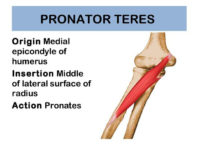
Pronator teres pronates the forearm, turning the palm down or back. If the elbow is flexed to a right angle, then pronator teres will turn the hand so that the palm faces inferiorly. It is assisted in this action by pronator quadratus.
It also weakly flexes the elbow, or assists in flexion at the elbow when there is strong resistance.
 There are two wrist flexors, two finger flexors, and one thumb flexor. Pronator teres, which pronates the arm, is included because of the common activation factors and its relationship to other thumb pain.
There are two wrist flexors, two finger flexors, and one thumb flexor. Pronator teres, which pronates the arm, is included because of the common activation factors and its relationship to other thumb pain.
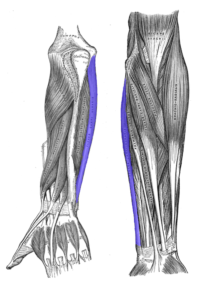 The flexor carpi ulnaris has two heads; a humeral head and an ulnar head. The humeral head originates from the medial epicondyle of the humerus via the common flexor tendon. The ulnar head originates from the medial margin of the olecranon of the ulnar and the upper two-thirds of the dorsal border of the ulnar by an aponeurosis. Between the two heads passes the ulnar nerve and ulnar artery.
The flexor carpi ulnaris has two heads; a humeral head and an ulnar head. The humeral head originates from the medial epicondyle of the humerus via the common flexor tendon. The ulnar head originates from the medial margin of the olecranon of the ulnar and the upper two-thirds of the dorsal border of the ulnar by an aponeurosis. Between the two heads passes the ulnar nerve and ulnar artery.
The tendon of flexor carpi ulnaris can be seen on the anterior surface of the distal forearm. On a person’s distal forearm, just before the wrist, there are either two or three tendons. The tendon of the flexor carpi ulnaris is the most medial (closest to the little finger) of these.

The flexor carpi radialis originates from the medial epicondyle of the humerus as part of the common flexor tendon. It runs just laterally of flexor digitorum superficialis and inserts on the anterior aspect of the base of the second metacarpal and has small slips to both the third metacarpal and trapezium tuberosity.
The tendon of the flexor carpi radialis is visible on the anterior surface of the forearm, just proximal to the wrist when the wrist is flexed. It is the tendon seen most lateral, closest to the thumb.
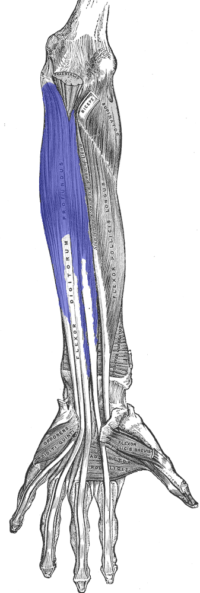 Flexor digitorum profundus originates in the upper 3/4 of the anterior and medial surfaces of the ulna, interosseous membrane, and deep fascia of the forearm. The muscle fans out into four tendons (one to each of the second to fifth fingers) to the palmar base of the distal phalanx.
Flexor digitorum profundus originates in the upper 3/4 of the anterior and medial surfaces of the ulna, interosseous membrane, and deep fascia of the forearm. The muscle fans out into four tendons (one to each of the second to fifth fingers) to the palmar base of the distal phalanx.
Along with the flexor digitorum superficialis, it has long tendons that run down the arm and through the carpal tunnel and attach to the palmar side of the phalanges of the fingers.
Flexor digitorum profundus lies deep to the superficialis, but it attaches more distally. Therefore, the profundus’s tendons go through the tendons of superficialis and end up attaching to the distal phalanx. For this reason, profundus is also called the perforating muscle.
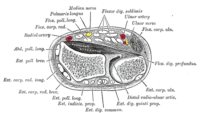 The flexor digitorum superficialis muscle lies above the flexor digitorum profundus. It has two heads – the humeroulnar and radial – and it is between these heads that the median nerve and ulnar artery pass. The ulnar collateral ligament of elbow joint gives its origin to part of this muscle.
The flexor digitorum superficialis muscle lies above the flexor digitorum profundus. It has two heads – the humeroulnar and radial – and it is between these heads that the median nerve and ulnar artery pass. The ulnar collateral ligament of elbow joint gives its origin to part of this muscle.
Four long tendons come off this muscle near the wrist and travel through the carpal tunnel formed by the flexor retinaculum. These tendons, along with those of flexor digitorum profundus, are enclosed by a common flexor sheath. The tendons attach to the anterior margins on the bases of the intermediate phalanges of the four fingers.
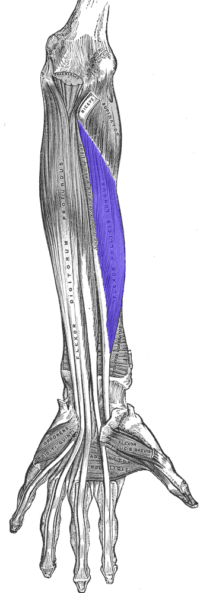 Flexor pollicis longus arises from the palm side of the body of the radius, extending from immediately below the radial tuberosity and oblique line to within a short distance of the pronator quadratus muscle.
Flexor pollicis longus arises from the palm side of the body of the radius, extending from immediately below the radial tuberosity and oblique line to within a short distance of the pronator quadratus muscle.
It arises also from the adjacent part of the interosseous membrane of the forearm, and generally by a fleshy slip from the medial border of the coronoid process of the ulna. In 40 percent of cases, it is also inserted from the medial epicondyle of the humerus, and in those cases a tendinous connection with the humeral head of the flexor digitorum superficialis is present.
The fibers end in a flattened tendon, which passes beneath the flexor retinaculum of the hand through the carpal tunnel. It is then lodged between the lateral head of the flexor pollicis brevis and the oblique part of the adductor pollicis, and, entering an osseoaponeurotic canal similar to those for the flexor tendons of the fingers, is inserted into the base of the distal phalanx of the thumb.
 The pronator teres has two heads—humeral and ulnar.
The pronator teres has two heads—humeral and ulnar.
- The humeral head, the larger and more superficial, arises from the medial supracondylar ridge immediately superior to the medial epicondyle of the humerus, and from the common flexor tendon (which arises from the medial epicondyle).
- The ulnar head (or ulnar tuberosity) is a thin fasciculus, which arises from the medial side of the coronoid process of the ulna, and joins the preceding at an acute angle.
The muscle passes obliquely across the forearm and ends in a flat tendon, which is inserted into a rough impression at the middle of the lateral surface of the body of the radius, just distal to the insertion of the supinator.
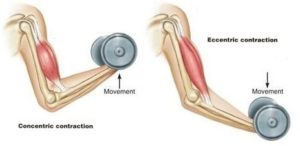 For example, in a biceps curl, you would use a concentric contraction of your biceps, coupled with an eccentric contraction of your triceps, to flex your elbow and push the weight up. As you lower the weight, eccentric contractions of your biceps are required to maintain control and prevent dropping the weight.
For example, in a biceps curl, you would use a concentric contraction of your biceps, coupled with an eccentric contraction of your triceps, to flex your elbow and push the weight up. As you lower the weight, eccentric contractions of your biceps are required to maintain control and prevent dropping the weight.
Isotonic Contractions
Isotonic contractions maintain constant tension in the muscle as the muscle changes length. This can occur only when a muscle’s maximal force of contraction exceeds the total load on the muscle. Isotonic muscle contractions can be either concentric (muscle shortens) or eccentric (muscle lengthens).Concentric Contractions
A concentric contraction is a type of muscle contraction in which the muscle shortens while generating force. This is typical of muscles that contract due to the sliding filament mechanism, and it occurs throughout the muscle. Such contractions also alter the angle of the joints to which the muscles are attached.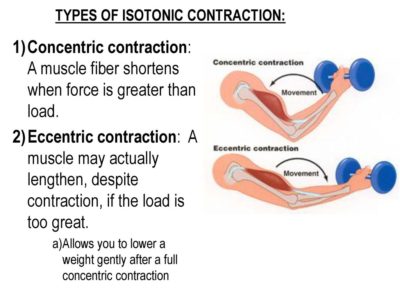 This occurs throughout the length of the muscle, generating force; causing the muscle to shorten and the angle of the joint to change. For instance, a concentric contraction of the biceps would cause the arm to bend at the elbow as the hand moves close to the shoulder (a biceps curl).
A concentric contraction of the triceps would change the angle of the joint in the opposite direction, straightening the arm and moving the hand away from the shoulder.
This occurs throughout the length of the muscle, generating force; causing the muscle to shorten and the angle of the joint to change. For instance, a concentric contraction of the biceps would cause the arm to bend at the elbow as the hand moves close to the shoulder (a biceps curl).
A concentric contraction of the triceps would change the angle of the joint in the opposite direction, straightening the arm and moving the hand away from the shoulder.
Eccentric Contractions
An eccentric contraction results in the lengthening of a muscle. These contractions decelerate muscles and joints (acting as “brakes” to concentric contractions) and can alter the position of the load force. During an eccentric contraction, the muscle lengthens while under tension due to an opposing force that is greater than the force generated by the muscle. However, rather than working to pull a joint in the direction of the muscle contraction, the muscle acts to decelerate the joint at the end of a movement or otherwise control the repositioning of a load. This can occur involuntarily (when attempting to move a weight too heavy for the muscle to lift) or voluntarily (when the muscle is “smoothing out” a movement). Strength training involving both eccentric and concentric contractions appears to increase muscular strength and joint stability more than training with concentric contractions alone.Isometric Contractions
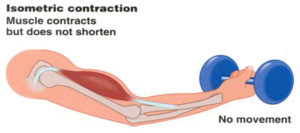 In contrast to isotonic contractions, isometric contractions generate force without changing the length of the muscle. This is typical of muscles found in the hands and forearm: the muscles do not change length, and joints are not moved, so force for grip is sufficient. An example is when the muscles of the hand and forearm grip an object; the joints of the hand do not move, but muscles generate sufficient force to prevent the object from being dropped.
For people with hypermobile joints, strength training can be a challenge. Tension stresses the connective tissues of the joint as force is transmitted through its range of motion. Isometric exercises can be ideal in these circumstances because there is minimal movement. This means that the joint is placed into vulnerable hyperextended positions under force.
In contrast to isotonic contractions, isometric contractions generate force without changing the length of the muscle. This is typical of muscles found in the hands and forearm: the muscles do not change length, and joints are not moved, so force for grip is sufficient. An example is when the muscles of the hand and forearm grip an object; the joints of the hand do not move, but muscles generate sufficient force to prevent the object from being dropped.
For people with hypermobile joints, strength training can be a challenge. Tension stresses the connective tissues of the joint as force is transmitted through its range of motion. Isometric exercises can be ideal in these circumstances because there is minimal movement. This means that the joint is placed into vulnerable hyperextended positions under force.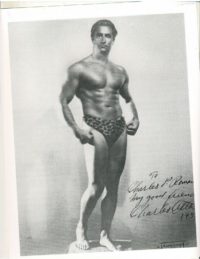 You can develop amazing strength without free weights, machines, or resistance bands.
One of the original bodybuilder gurus from the 1920s, Charles Atlas, based his workouts primarily on isometric exercises, eventually even trademarking a term for his exercise method that he called "Dynamic Tension."
If you have hypermobile joints you can strength train safely at home with isometric exercises.
You can develop amazing strength without free weights, machines, or resistance bands.
One of the original bodybuilder gurus from the 1920s, Charles Atlas, based his workouts primarily on isometric exercises, eventually even trademarking a term for his exercise method that he called "Dynamic Tension."
If you have hypermobile joints you can strength train safely at home with isometric exercises.
